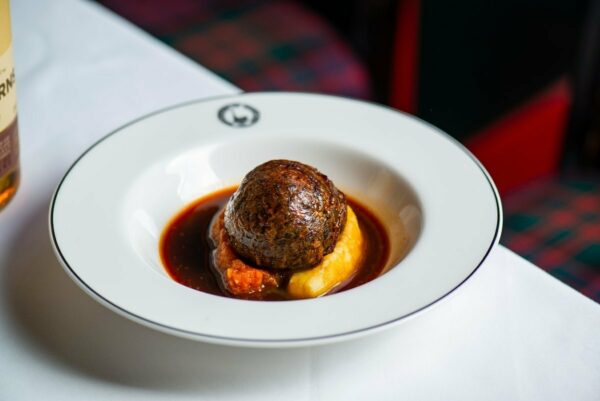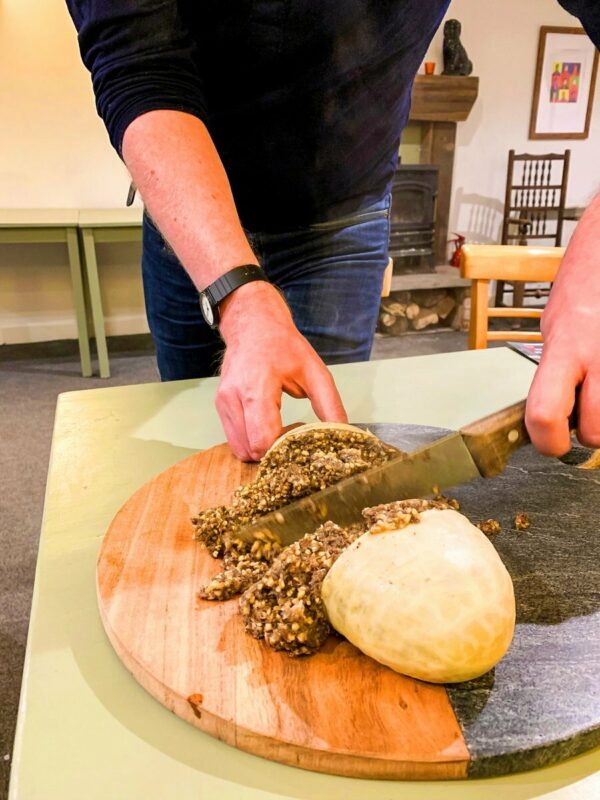Warm-Reekin', Rich!
How did a national dish inspired poets and partisans? Rob Crossan went on a haggis-making course in Dunbartonshire to find out why

By Rob Crossan
July 6 2023
Haggis may be deeply imbued with Robbie Burns, kirks, lochs, glens and “dreich” (Scotland’s famously gloomy weather), but it’s to an English poet, not the Scottish bard, that I find myself turning for solace as the inner workings of haggis- making are explained to me. “Where ignorance is bliss, Tis folly to be wise”, wrote Thomas Gray, the 18th-century poet, in his Ode on a Distant Prospect of Eton College. And never have I had more empathy with an Old Etonian than now.
Just as I have long felt my life to be more naïve yet also more sanguine for not knowing the intimate details of, let’s say, Donald Trump’s sex life or the inner machinations of a North Korean labour camp, so my enjoyment of haggis over the last three decades rests to a large extent on my utter ignorance of its ingredients.
I’d heard the rumours about sheep’s stomach lining, plastic ‘sleeves’ and a salt content that would strain the supply of the Dead Sea. But I’m now in the company of perhaps Scotland’s first haggis de-mystifier. Lee Rooney, a native of Galway but a resident of Scotland for more than 30 years, is driving me from the stout village of Milngavie (inexplicbly pronounced ‘Mo-guy’), 30 miles north of Glasgow in a region of crumpled fields, blind glens, and slab-like granite clouds, to a spruced-up “bothy” – that’s a mountain hut, for those unfamiliar with Gaelic. It’s only summer, but I’ll be prepared come January.

This is the HQ for Lee’s brand new venture – The Haggis Experience, the only hands-on workshop in Scotland where anyone can create the dish that Burns himself famously described as the “great chieftain o’ the puddin’ race”.
“It’s basically medieval ‘boil in the bag’,” Lee says as he strides into the bothy which, with its Farrow & Ball paintwork, cosy modern kitchen and fireplace, is usually used by the guns on pheasant shoots in the adjoining fields.
The comparison to Britain’s first foray into sophisticated international cuisine – courtesy of 1970s food manufacturer Vesta, and its range of plastic bagged curries – is reassuring, particularly after hearing Lee talk of “pluck” during our drive. That, I learn with a turbulent stomach, is the collective word for a sheep or lamb’s heart, liver, lungs and oesophagus, which are the central ingredients of a haggis. “The only bit you remove from the pluck is the windpipe, as it’s got absolutely no nutritional value,” Lee says. “Think of it like an Airfix model.” As I start to remove it I wonder if I should go vegan. Yet when I see them laid out on the bothy’s kitchen table, the ingredients are just what you’d see in a butcher’s window. The chopped heart, liver and lungs resemble stewing steak, while the pinhead oats and beef suet are entirely harmless to my eyes and nose.
“This is a meal created for survival,” Lee says as I use a mincer to grind the offal before adding white pepper and mace powder (the outer casing of nutmeg) to the claggy mix. “There’s no exact recipe for a haggis,” he explains. “It dates back to the 1500s, when huntsmen would butcher a beast on the spot after it was killed. In Scotland back then, it was more likely to be deer than sheep, but there was a definite hierarchy. Those in the higher echelons got the better cuts and the haggis was the offcuts given to the lower ranks.”

Such is the irony of Burns Night (25 January): this dish, which has inspired poets, is actually the most humble meal one could imagine. The modern equivalent would be a Domino’s pizza underneath a silver cloche dome. The instant I begin to knead the offal, oats, pepper and mace, the aroma emerges. There’s something fugitive about it; malodorous yet unctuous, warming and buoyant. As the leading independent distributor of MacSween haggis in Scotland, Lee is uninterested in pulling the wool over my eyes when it comes to the evolution of haggis making.
“The biggest haggis makers can’t use sheep’s stomach casing for haggis. They use plastic sleeves. But the truth is that nobody uses sheep stomach casing anymore,” Lee tells me. “The way that abattoirs slaughter animals these days means you can’t get hold of an intact sheep’s stomach casing. So if you’re making a properly traditional haggis these days, you’re almost certainly going to use an ox bung instead.” The bung is the small intestine, and it’s the only part of the haggis-making process where those of a more delicate constitution might need to ready themselves in advance.
The yellow-white bung resembles a cross between a condom designed by a Victorian producer of barrage balloons and a cheerless, miserly Christmas stocking. Unperturbed, Lee stretches open the top of the bung as I scoop in the haggis mixture. Once again, that spiced, salted aroma works its Braveheart-esque magic, rendering the experience comical rather than nauseating.
Haggis requires around six-and-a-half hours on the stove. With my creation not ready until midnight, I’m served a plate of haggis which, in true Blue Peter-style, Lee made earlier.
Coarse, sinew-y and moist; the finest haggis never coats your mouth in fat. Rather the mace lends the dish a clove-like flavour, with overtones of blood, soil, hot breath and fresh kills.
“It’s not a gross-out, as you can see,” Lee says, serving me a second plate of haggis as the leaden clouds sink lower outside. “It’s incredible how many people who adore haggis and have lived in Scotland all their lives come to do this workshop and admit that they have no idea how it’s made. I don’t try to cover anything up. This is how it works. And it’s nothing to be scared of.”
Indeed, it could be argued that the haggis we eat today is a diluted product compared to what Burns may have eaten.
“You actually wouldn’t want to go too traditional with a haggis,” Lee insists. “Recipes from 400 years ago used four times the salt and twice the fat. To the modern palate, it would taste absolutely dreadful.”
For now, I am sated. Getting inside the skin of the haggis has not diminished my appetite for what Burns described as a “glorious sight”. Not a phrase you can imagine ever being assigned to a deep-pan stuffed crust pizza.
To join The Haggis Experience, ring 07708 670944; or visit thehaggisexperience.com.
